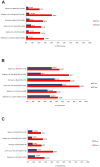Biological significance and prognostic/predictive impact of complex karyotype in chronic lymphocytic leukemia
- PMID: 30344950
- PMCID: PMC6188145
- DOI: 10.18632/oncotarget.26146
Biological significance and prognostic/predictive impact of complex karyotype in chronic lymphocytic leukemia
Abstract
The complex karyotype (CK) is an established negative prognostic marker in a number of haematological malignancies. After the introduction of effective mitogens, a growing body of evidence has suggested that the presence of 3 or more aberrations by conventional banding analysis (CBA) is associated with an unfavorable outcome in chronic lymphocytic leukemia (CLL). Thus, the importance of CBA was recognized by the 2018 guidelines of the International Workshop on CLL, which proposed the introduction of CBA in clinical trials to validate the value of karyotype aberrations. Indeed, a number of observational studies showed that cytogenetic aberrations and, particularly, the CK may have a negative independent impact on objective outcome measures (i.e. time to first treatment, progression free survival, time to chemorefractoriness and overall survival) both in patients treated with chemoimmunotherapy and, possibly, in patients receiving novel mechanism-based treatment. Here, we set out to present the scientific evidence supporting the significance of CK as a prognostic marker in CLL and to discuss the biological basis showing that the CK is a consequence of genomic instability.
Keywords: Richter transformation; chronic lymphocytic leukemia; complex karyotype; prognosis; target therapy.
Conflict of interest statement
CONFLICTS OF INTEREST The authors declare no conflicts of interest.
Figures



References
-
- Jemal A, Siegel R, Ward E, Murray T, Xu J, Thun MJ. Cancer statistics, 2007. CA Cancer J Clin. 2007;57:43–66. - PubMed
-
- The Surveillance Epidemiology and End Results (SEER) Program of the National Cancer Institute Cancer fact sheets: chronic lymphocytic leukemia (CLL) https://seer.cancer.gov/statfacts/html/clyl.html. - PubMed
-
- Chiorazzi N, Rai KR, Ferrarini M. Chronic lymphocytic leukemia. N Engl J Med. 2005;352:804–815. - PubMed
-
- Zenz T, Fröhling S, Mertens D, Döhner H, Stilgenbauer S. Moving from prognostic to predictive factors in chronic lymphocytic leukaemia (CLL) Best Pract Res Clin Haematol. 2010;23:71–84. - PubMed
Publication types
LinkOut - more resources
Full Text Sources
Research Materials

